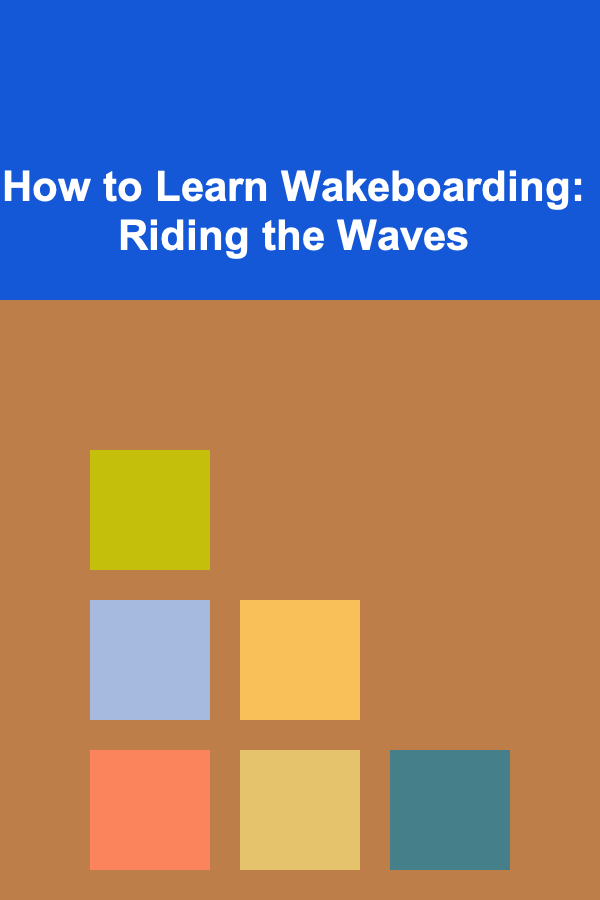
How to Learn Wakeboarding: Riding the Waves
ebook include PDF & Audio bundle (Micro Guide)
$12.99$9.99
Limited Time Offer! Order within the next:

Wakeboarding is an exciting water sport that combines elements of waterskiing, snowboarding, and surfing. The thrill of riding the waves while being towed behind a boat, performing tricks and stunts, or simply cruising through the water, makes wakeboarding an incredibly popular activity for water sports enthusiasts. Whether you're a complete beginner or someone looking to improve your skills, this guide will walk you through the essentials of wakeboarding, from the basics to advanced techniques.
Understanding Wakeboarding
Wakeboarding is performed on a small, specially designed board while being towed by a motorized boat. Riders maintain balance as they glide across the water, using the boat's wake to perform jumps, tricks, and other maneuvers. This sport requires a combination of balance, strength, and coordination, making it an excellent workout for both the upper and lower body.
Before you start learning wakeboarding, it's important to understand the components of the sport. Key elements include:
- The Wake: The wake is the large wave created by the boat as it moves through the water. Wakeboarders use this wave to perform jumps and tricks. The size and shape of the wake depend on the boat's speed, size, and hull design.
- The Tow Rope: The tow rope is used to pull the rider behind the boat. It should be of a suitable length to allow the rider to stay close enough to the boat to maintain control but far enough to use the wake effectively.
- The Board: A wakeboard is a flat, rectangular board with bindings that secure your feet. The type of wakeboard you use depends on your skill level and the type of wakeboarding you want to do.
Preparing to Learn Wakeboarding
Before hitting the water, it's essential to understand the equipment and conditions required for wakeboarding. Proper preparation ensures safety and helps speed up the learning process.
Gear and Equipment
- Wakeboard: The first piece of gear you'll need is a wakeboard. Wakeboards come in different shapes, sizes, and types. A beginner's wakeboard is typically softer and more forgiving, while advanced boards are stiffer, offering better control and precision. Choose a wakeboard based on your weight, skill level, and the kind of riding you plan to do.
- Bindings: Bindings are crucial as they secure your feet to the wakeboard. Make sure they fit comfortably but are also snug enough to give you control. Different types of bindings include open-toe and closed-toe models.
- Life Jacket: A life jacket is a must for safety, particularly for beginners. It helps with buoyancy and ensures you stay afloat in the water.
- Tow Rope: The tow rope is generally made of durable materials such as nylon and should be approximately 60 feet in length. The rope's handle provides a firm grip, and the rope itself needs to be of appropriate thickness to prevent any damage when the boat pulls the rider.
- Helmet: Though not always mandatory, a helmet provides additional protection in case of falls. It's especially important for beginners who are still learning balance and control.
Water Conditions
The conditions of the water play a significant role in wakeboarding performance. Calm, smooth water is ideal for beginners, as choppy water can make it more difficult to maintain control. Early mornings or late afternoons often provide the calmest water, as boat traffic is lower, and the wind tends to be calmer.
Additionally, pay attention to the weather conditions. Strong winds or thunderstorms can make wakeboarding unsafe, so always check the forecast before heading out. It's also important to learn how to assess the water depth to avoid injuries from hitting the bottom of shallow water.
Finding a Boat
The next step is to find a boat that can tow you while you're wakeboarding. Wakeboarding boats are specifically designed with a powerful engine and a hull that creates a good wake. If you're just starting out, consider renting a boat with an experienced driver who can help you with the basics.
Alternatively, if you have friends or family with a boat, make sure they are familiar with towing a wakeboarder. The boat driver plays a crucial role in ensuring the rider's safety by maintaining the right speed and providing a consistent pull.
Basic Techniques for Beginners
Once you've prepared the gear and conditions, it's time to get started. For beginners, the first experience on a wakeboard can be challenging, but with patience and practice, you'll soon be cruising across the water with ease.
Getting Into Position
- Positioning in the Water: When you first enter the water, position yourself facing the boat, with your knees tucked toward your chest and your toes pointed slightly upward. Hold the tow rope handle with both hands, keeping your elbows slightly bent.
- Boat Start: As the boat begins to move forward, it will gradually pull you upright. Keep your arms extended and your body in a crouched position. Allow the boat's speed to help you rise from the water, but avoid pulling too hard on the rope.
- Standing Up: Once you're being pulled, the key is to focus on standing up slowly, not in one sudden motion. Let the boat's pull guide you upward while maintaining a slight bend in your knees. It's important to keep your weight centered on the board.
Finding Your Balance
Balance is crucial when wakeboarding, and it takes time to develop. As you stand up, remember these tips:
- Keep Your Knees Bent: Maintain a slightly bent knee position to absorb the force of the wake and maintain stability.
- Focus on Your Feet: The board will naturally try to go in the direction of your feet. Keep your feet slightly apart and pointed forward, and try to distribute your weight evenly across the board.
- Use Your Hips: Keep your hips relaxed and aligned with the board. This will help you maintain a smooth ride and prevent unnecessary movements.
Turning and Steering
Once you're comfortable with standing up and balancing, you can start to learn how to steer and make turns. Wakeboarding uses a technique called "carving," which involves shifting your weight from edge to edge of the board.
- Turning Left or Right: To turn left, gently shift your weight to your toes. To turn right, shift your weight to your heels. The more you lean, the sharper the turn will be. Remember to keep your body relaxed and avoid over-leaning.
- Carving: Carving is the ability to make smooth, controlled turns by shifting your weight back and forth on the board. Start with gentle carving and work up to more aggressive turns as your confidence grows.
Falling and Getting Back Up
Falling is part of the learning process. Wakeboarding can be physically demanding, and it's common to fall while you're learning. When you fall, relax and let the boat pull you back to the surface. To get back up, position yourself in the same stance as when you first started, with your knees bent and your feet centered on the board. The boat driver will slow down to give you time to reposition and begin again.
Progressing to Advanced Techniques
As you gain confidence in the basics of wakeboarding, it's time to begin learning more advanced techniques. These techniques involve using the wake to perform jumps, spins, and other tricks that add excitement to your ride.
Jumping the Wake
One of the most thrilling aspects of wakeboarding is launching off the wake to perform jumps and tricks. To jump the wake:
- Approach the Wake: Begin by carving toward the wake. When you're close enough, prepare by bending your knees slightly, anticipating the pull from the boat.
- Edge the Board: As you approach the wake, edge your board against the pull of the boat. This will load up the tension in the rope.
- Launch Off the Wake: As you hit the wake, extend your legs and push off the wave, using the boat's pull to propel you into the air.
- In the Air: Keep your body centered and prepare for landing by bending your knees slightly upon descent.
Spins and Tricks
Once you're comfortable with basic jumps, you can start learning spins and tricks. A spin involves rotating your body 180 or 360 degrees in the air while staying on the wakeboard.
- 360 Spins: To perform a 360 spin, carve toward the wake and use your arms and shoulders to rotate your body. It may take a few tries to get the timing and balance right.
- Grabs: A grab is when you reach down and grab the edge of the board while in the air. Start with a simple grab, such as the nose grab, where you hold the front edge of the board as you jump.
Wake-to-Wake Riding
This advanced technique involves crossing the boat's wake, jumping from one side to the other, and landing on the opposite wake. To master this:
- Approach the wake from the side, using your edges to carve toward the peak of the wake.
- Use the boat's pull to launch yourself across to the other side.
- Keep your knees bent for a soft landing and prepare to carve in the opposite direction.
Safety Tips
While wakeboarding is an exciting sport, it's crucial to prioritize safety. Follow these guidelines to ensure your safety and that of others:
- Always Wear a Life Jacket: Even if you're an experienced rider, always wear a life jacket for safety.
- Warm-Up Before Riding: Stretch your muscles to prevent injury and improve your flexibility.
- Start Slow: Begin with slow speeds and gradually increase your speed as you become more comfortable.
- Stay Aware of the Boat's Path: Always keep an eye on the boat and the driver's movements. Pay attention to changes in speed and direction.
- Know Your Limits: Take breaks when needed and avoid pushing yourself too hard. Listen to your body to avoid overexertion.
Conclusion
Learning wakeboarding is an exciting challenge that requires practice, patience, and a lot of enthusiasm. Whether you're just starting or are looking to advance your skills, wakeboarding provides endless opportunities for progression and fun. By mastering the basics, gradually increasing your skills, and staying safe, you'll be riding the waves in no time!
Reading More From Our Other Websites
- [Personal Care Tips 101] How to Find the Perfect Makeup Primer for Your Skin Concerns
- [Home Maintenance 101] How to Clean and Maintain Your Dryer Vent to Prevent Fires
- [Home Party Planning 101] How to Organize a Themed Brunch Party at Home
- [Personal Care Tips 101] How to Use Teeth Whitening Strips for Optimal Results
- [Home Staging 101] How to Create a Must-Have Guide to Home Staging Resources
- [Personal Financial Planning 101] How to Prepare for Financial Stability After a Job Loss
- [Horseback Riding Tip 101] Horseback vs. Pony Riding: Which is Best for Beginners?
- [Organization Tip 101] How to Declutter Your Closet in Just One Weekend
- [Home Storage Solution 101] How to Declutter and Organize Your Bathroom Vanity Storage: A Minimalist Approach
- [Home Pet Care 101] How to Create a Stimulating Environment for Your Pet During Long Periods of Absence from Home

How to Create a Checklist for Enhancing Your Content's Tone and Voice: An Actionable Guide
Read More
How to Install and Use Security Cameras Effectively
Read More
The Role of Mentorship in Job Preparation: Finding the Right Guide
Read More
How to Plan Your Monthly Self-Care Routine
Read More
10 Tips for Mastering the Break Shot in Billiards
Read More
How to Habit Track for Sustainable Living
Read MoreOther Products

How to Create a Checklist for Enhancing Your Content's Tone and Voice: An Actionable Guide
Read More
How to Install and Use Security Cameras Effectively
Read More
The Role of Mentorship in Job Preparation: Finding the Right Guide
Read More
How to Plan Your Monthly Self-Care Routine
Read More
10 Tips for Mastering the Break Shot in Billiards
Read More